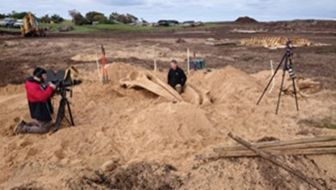Southern Right and Humpback Whales, some with calves, have been spotted at various places as they move through on their annual migration along the coast mainly between Lorne and Cape Otway.
Although it is out of our immediate area, I thought the following item might be of interest.
In early June, staff from the Melbourne Museum went to Warrnambool to retrieve the bones of a Balaenoptera physalus Fin Whale, which had been washed up on a beach there in 2014. The specimen, a female, 16 metres long and weighing 25–30 tonne, was in an emaciated condition, and probably died from malnutrition.

The skeleton was laid out in a farmer’s field near Warrnambool. Local sand from a quarry was used to completely cover the carcass, and a piece of old carpet was placed over the top to keep it stable, and enable the remainder of the flesh attached to the bones, to rot away. After eight months, the skeleton had been 95 per cent cleaned. It is Victoria’s first complete specimen of a Fin Whale, and will be taken to the Museum to be used for education and research.

The Fin Whale is listed by the IUCN as endangered. They live throughout the world’s oceans, with higher densities in cooler waters. They feed mainly on krill. Fin Whales, so called because of their projecting dorsal fin, are the thinnest and fastest swimming of the baleen whales.
The Friends of Eastern Otways conduct mammal surveys in the Great Otway National Park using remote, motion sensor cameras. After detecting several small mammal footprints in the sand dunes, they set out five cameras along the foreshore near Urquhart Bluff.
The cameras have produced some excellent photographs and video of two species of bandicoot – the Long-nosed and the Southern Brown. They could be seen feeding and moving in and around the dense vegetation cover on the sand dunes. This strip of foreshore habitat provides fair protection for small animals from any predators that may intrude.
Recently, while driving along Jarosite Road, the car ahead of me hit an immature Gang-gang Cockatoo. The bird was left on the road, appearing to be concussed. I wrapped it in a towel before contacting the Surf Coast Wildlife rescue. I was able to hand the bird to their care. Sadly the bird died a few hours later from head injuries caused by the road trauma.
The Surf Coast Wildlife Shelters Group Inc. is based in Torquay, and provides a 24 hour rescue service. As well, they have foster carers in Bellbrae, Anglesea and Aireys Inlet.
The contact telephone number for local injured wildlife is 0490 035 006. This number will also replace the present emergency number on the VicRoads Injured Wildlife signs.
Kaye Traynor